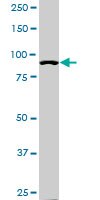CB1024 Sigma-AldrichAnti-ACTN4 Mouse mAb (4D10)
Anti-ACTN4, mouse monoclonal, clone 4D10, recognizes the ~90-100 kDa ACTN4 in PC-12, HeLa, Raw 264.7, MCF-7, NIH3T3 cells & in human testes. It is validated for ELISA, WB, ICC, and paraffin sections.
More>> Anti-ACTN4, mouse monoclonal, clone 4D10, recognizes the ~90-100 kDa ACTN4 in PC-12, HeLa, Raw 264.7, MCF-7, NIH3T3 cells & in human testes. It is validated for ELISA, WB, ICC, and paraffin sections. Less<<Sinonimi: Anti-Actinin α4
Prodotti consigliati
Panoramica
| Replacement Information |
|---|
Tabella delle specifiche principali
| Species Reactivity | Host | Antibody Type |
|---|---|---|
| H, M, R | M | Monoclonal Antibody |
Prezzi e disponibilità
| Numero di catalogo | Disponibilità | Confezionamento | Qtà/conf | Prezzo | Quantità | |
|---|---|---|---|---|---|---|
| CB1024-100UG |
|
100 μg |
|
— |
| References | |
|---|---|
| References | Yamada, S., et al. 2010. Int. J. Oral Maxillofac. Surg. 39, 61. |
| Product Information | |
|---|---|
| Form | Liquid |
| Formulation | In PBS, pH 7.2. |
| Negative control | 293T cells |
| Positive control | PC-12 cells, HeLa cells, Raw 264.7 cells, MCF-7 cells, NIH3T3 cells, Human testes tissue |
| Preservative | None |
| Quality Level | MQ100 |
| Physicochemical Information |
|---|
| Dimensions |
|---|
| Materials Information |
|---|
| Toxicological Information |
|---|
| Safety Information according to GHS |
|---|
| Safety Information |
|---|
| Product Usage Statements |
|---|
| Packaging Information |
|---|
| Transport Information |
|---|
| Supplemental Information |
|---|
| Specifications |
|---|
| Global Trade Item Number | |
|---|---|
| Numero di catalogo | GTIN |
| CB1024-100UG | 04055977228694 |
Documentation
Anti-ACTN4 Mouse mAb (4D10) MSDS
| Titolo |
|---|
Anti-ACTN4 Mouse mAb (4D10) Certificati d'Analisi
| Titolo | Numero di lotto |
|---|---|
| CB1024 |
Riferimenti bibliografici
| Panoramica delle referenze |
|---|
| Yamada, S., et al. 2010. Int. J. Oral Maxillofac. Surg. 39, 61. |













